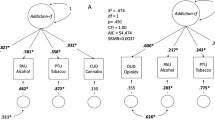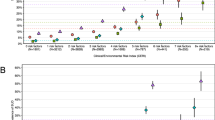Abstract
Transmissible liability index (TLI), developed employing a high-risk design and item response theory, enables quantification of the latent trait of liability to drug use disorders (DUD) in children. TLI has been shown to have high heritability and predict DUD in young adulthood. This study extends prior research and determines the genetic contribution of DUD liability measured by TLI to adult liability as indexed by DUD diagnosis. The study utilizes data from a twin sample tracked from age 11 to age 25. In addition to confirming TLI’s high heritability and predictive validity, it shows that the genetic component of variance in TLI assessed in childhood accounts for over half of the genetic variance in DUD diagnosis and the entire phenotypic relationship between the two liability measures. This validates TLI as an early measure of DUD liability and supports its utility in early-age genetic and other mechanistic studies of DUD.

Similar content being viewed by others
Notes
In the NIMH approach, the neurobiological mechanisms are supposed to “inform” the Research Domain Criteria (RDoC), which renders those mechanisms effectively subsumed under the RDoC. In the liability index approach, as employed, e.g., in the development of TLI, the phenotype remains at the same psychological/behavioral level of biological organization as the disorder diagnosis, which allows studying mechanisms as independent variables while augmenting the diagnostic classification.
References
Baker JH, Maes HH, Larsson H, Lichtenstein P, Kendler KS (2011) Sex differences and developmental stability in genetic and environmental influences on psychoactive substance consumption from early adolescence to young adulthood. Psychol Med 41:1907–1916
Conway KP, Levy J, Vanyukov M, Chandler R, Rutter J, Swan GE, Neale M (2010) Measuring addiction propensity and severity: the need for a new instrument. Drug Alcohol Depend 111:4–12
Dominicus A, Skrondal A, Gjessing HK, Pedersen NL, Palmgren J (2006) Likelihood ratio tests in behavioral genetics: problems and solutions. Behav Genet 36:331–340
Embretson SE, Reise SP (2000) Item Response Theory for Psychologists. Lawrence Erlbaum Associates Inc., Publishers, Mahwah
Falconer DS (1965) The inheritance of liability to certain diseases, estimated from the incidence among relatives. Ann Hum Genet 29:51–76
Faul F, Erdfelder E, Buchner A, Lang A-G (2009) Statistical power analyses using G*Power 3.1: tests for correlation and regression analyses. Behav Res Methods 41:1149–1160
Fulkerson JA, Harrison PA, Beebe TJ (1999) DSM-IV substance abuse and dependence: are there really two dimensions of substance use disorders in adolescents? Addiction 94:495–506
Hamilton CM, Strader LC, Pratt JG, Maiese D, Hendershot T, Kwok RK, Hammond JA, Huggins W, Jackman D, Pan H, Nettles DS, Beaty TH, Farrer LA, Kraft P, Marazita ML, Ordovas JM, Pato CN, Spitz MR, Wagener D, Williams M, Junkins HA, Harlan WR, Ramos EM, Haines J (2011) The PhenX Toolkit: get the most from your measures. Am J Epidemiol 174:253–260
Hartman CA, Gelhorn H, Crowley TJ, Sakai JT, Stallings M, Young SE, Rhee SH, Corley R, Hewitt JK, Hopfer CJ (2008) An item response theory analysis of DSM-IV cannabis abuse and dependence criteria in adolescents. J Am Acad Child Adolesc Psychiatry 47:165–173
Hicks BM, Iacono WG, McGue M (2012) Index of the transmissible common liability to addiction: heritability and prospective associations with substance abuse and related outcomes. Drug Alcohol Dep 123:S18–S23
Hoekstra RA, Bartels M, Boomsma DI (2007) Longitudinal genetic study of verbal and nonverbal IQ from early childhood to young adulthood. Learning Ind Diff 17:97–114
Hopfer CJ, Crowley TJ, Hewitt JK (2003) Review of twin and adoption studies of adolescent substance use. J Am Acad Child Adolesc Psychiatry 42:710–719
Iacono WG, Carlson SR, Taylor J, Elkins IJ, McGue M (1999) Behavioral disinhibition and the development of substance-use disorders: findings from the Minnesota Twin Family Study. Dev Psychopathol 11:869–900
Iacono WG, Malone SM, McGue M (2009) Behavioral disinhibition and the development of early-onset addiction: common and specific influences. Annu Rev Clin Psychol 4:25–348
Kendler KS, Jacobson KC, Prescott CA, Neale MC (2003a) Specificity of genetic and environmental risk factors for use and abuse/dependence of cannabis, cocaine, hallucinogens, sedatives, stimulants, and opiates in male twins. Am J Psychiatry 160:687–695
Kendler KS, Prescott CA, Myers J, Neale MC (2003b) The structure of genetic and environmental risk factors for common psychiatric and substance use disorders in men and women. Arch Gen Psychiatry 60:929–937
Kendler KS, Myers J, Prescott CA (2007) Specificity of genetic and environmental risk factors for symptoms of cannabis, cocaine, alcohol, caffeine, and nicotine dependence. Arch Gen Psychiatry 64:1313–1320
Kirisci L, Tarter R, Mezzich A, Ridenour T, Reynolds M, Vanyukov M (2009) Prediction of cannabis use disorder between boyhood and young adulthood clarifying the phenotype and environtype. Am J Addictions 18:36–47
Kirisci L, Tarter R, Reynolds M, Ridenour T, Stone C, Vanyukov M (2012) Computer adaptive testing of liability to addiction: identifying individuals at risk. Drug Alcohol Depend 123:S79–S86
Krueger RF, Hicks BM, Patrick CJ, Carlson SR, Iacono WG, McGue M (2002) Etiologic connections among substance dependence, antisocial behavior, and personality: modeling the externalizing spectrum. J Abnorm Psychol 111:411–424
McGue M, Elkins I, Iacono WG (2000) Genetic and environmental influences on adolescent substance use and abuse. Am J Med Genet B 96:671–677
Neale MC, Cardon LR (1992) Methodology for Genetic Studies of Twins and Families. Kluwer Academic, Dortrecht
Neale MC, Boker SM, Xie G, Maes HH (2003) Mx: Statistical Modeling. VCU Box 900126, Richmond, VA 23298: Department of Psychiatry. 6th edition
NIMH (2011) NIMH Research Domain Criteria (RDoC), http://www.nimh.nih.gov/research-funding/rdoc/nimh-research-domain-criteria-rdoc.shtml (Online document: retrieved on 2/19/2014)
Palmer RHC, Button TM, Rhee SH, Corley RP, Young SE, Stallings MC, Hopfer CJ, Hewitt JK (2012) Genetic etiology of the common liability to drug dependence: evidence of common and specific mechanisms for DSM-IV dependence symptoms. Drug Alc Dep 123:S24–S32
Reckase MD (1979) Unifactor latent trait models applied to multifactor tests: results and implications. J Educ Stat 15:65–75
Rice JP, Cloninger CR, Reich T (1980) General causal models for sex differences in the familial transmission of multifactorial traits: an application to human spatial visualizing ability. Soc Biol 26:36–47
Robins LN, Babor TF, Cottler LB (1987) Composite International Diagnostic Interview: Expanded Substance Abuse Module. Washington University, St. Louis
Samejima F (1969) Estimation of latent trait ability using a response pattern of graded scores. Psychometrika Monograph N6:17
StataCorp (2013) Stata User’s Guide Release 13. A Stata Press Publication, College Station
Takayanagi Y, Spira AP, Roth KB, Gallo JJ, Eaton WW, Mojtabai R (2014) Accuracy of reports of lifetime mental and physical disorders: results from the Baltimore Epidemiological Catchment Area Study. JAMA Psychiatry 71:273–280
Tsuang MT, Lyons MJ, Meyer JM, Doyle T, Eisen SA, Goldberg J, True W, Lin N, Toomey R, Eaves L (1998) Co-occurrence of abuse of different drugs in men: the role of drug-specific and shared vulnerabilities. Arch Gen Psychiatry 55:967–972
Vanyukov MM, Tarter RE (2000) Genetic studies of substance abuse. Drug Alcohol Dep 59:101–123
Vanyukov MM, Moss HB, Plail JA, Blackson T, Mezzich AC, Tarter RE (1993) Antisocial symptoms in preadolescent boys and in their parents: associations with cortisol. Psychiat Res 46:9–17
Vanyukov MM, Kirisci L, Tarter RE, Simkevitz HF, Kirillova GP, Maher BS, Clark DB (2003a) Liability to substance use disorders: 2. A measurement approach. Neurosci Biobehav Rev 27:517–526
Vanyukov M, Moss H, Tarter R (2003b) Research designs in family studies. In: Sloboda Z, Bukowski WJ (eds) Handbook of Drug Abuse Prevention: Theory Science and Practice. Kluwer Academic/Plenum Publishers, New York, pp 497–519
Vanyukov MM, Tarter RE, Kirisci L, Kirillova GP, Maher BS, Clark DB (2003c) Liability to substance use disorders: 1. Common mechanisms and manifestations. Neurosci Biobehav Rev 27:507–515
Vanyukov MM, Kirisci L, Moss L, Tarter RE, Reynolds MD, Maher BS, Kirillova GP, Ridenour T, Clark DB (2009) Measurement of the risk for substance use disorders: phenotypic and genetic analysis of an index of common liability. Behav Genet 39:233–244
Vanyukov MM, Tarter RE, Kirillova GP, Kirisci L, Reynolds MD, Kreek MJ, Conway KP, Maher BS, Iacono WG, Bierut L, Neale MC, Clark DB, Ridenour TA (2012) Common liability to addiction and “gateway hypothesis”: theoretical, empirical and evolutionary perspective. Drug Alcohol Dep 123:S3–S17
Vrieze SI, Perlman G, Krueger RF, Iacono WG (2012) Is the continuity of externalizing psychopathology the same in adolescents and middle–aged adults? A test of the externalizing spectrum’s developmental coherence. J Abnorm Child Psychol 40:459–470
Wu H, Neale MC (2012) Adjusted confidence intervals for a bounded parameter. Behav Genet 42:886–898
Wu H, Neale MC (2013) On the likelihood ratio tests in bivariate ACDE models. Psychometrika 78:441–463
Acknowledgments
This study was supported by the National Institute on Drug Abuse Grant P50DA005605.
Conflict of Interest
The authors declare that they have no conflict of interest.
Human and Animal Rights and Informed Consent
All procedures performed were approved by the University of Minnesota Institutional Review Board and are in accordance with the 1964 Helsinki declaration and its later amendments or comparable ethical standards. All participants provided informed consent.
Author information
Authors and Affiliations
Corresponding author
Additional information
Edited by Stacey Cherny.
Kevin Kim—Deceased.
Rights and permissions
About this article
Cite this article
Vanyukov, M., Kim, K., Irons, D. et al. Genetic Relationship Between the Addiction Diagnosis in Adults and Their Childhood Measure of Addiction Liability. Behav Genet 45, 1–11 (2015). https://doi.org/10.1007/s10519-014-9684-4
Received:
Accepted:
Published:
Issue Date:
DOI: https://doi.org/10.1007/s10519-014-9684-4




